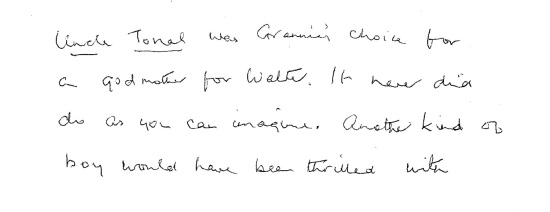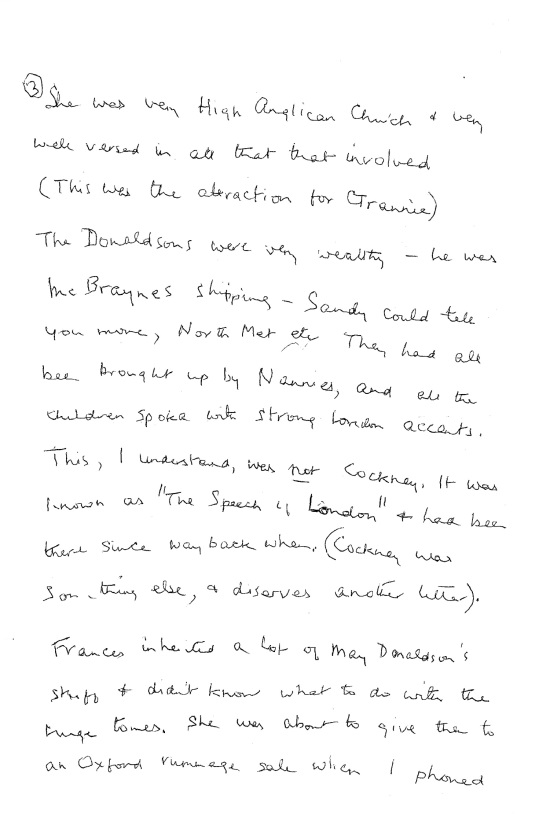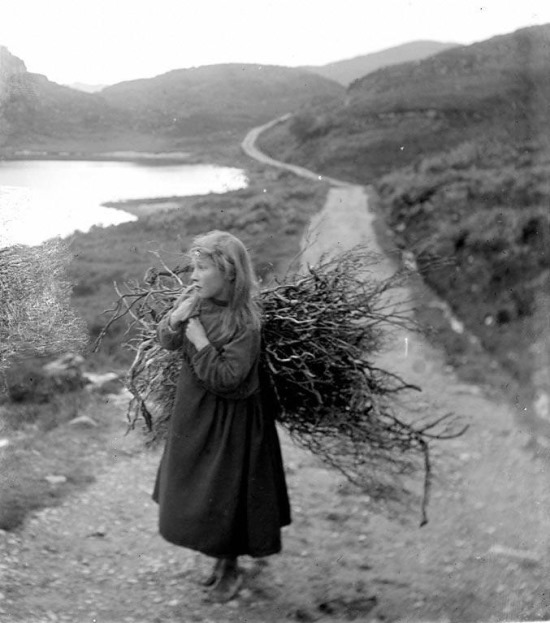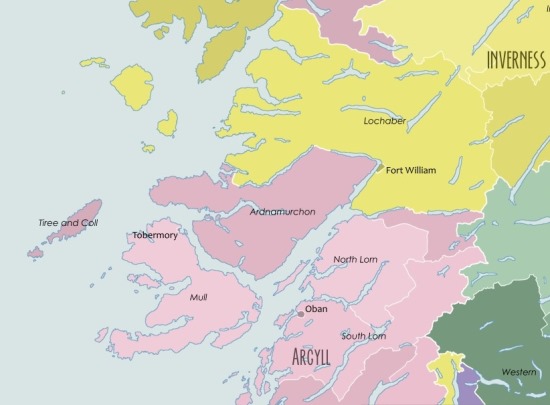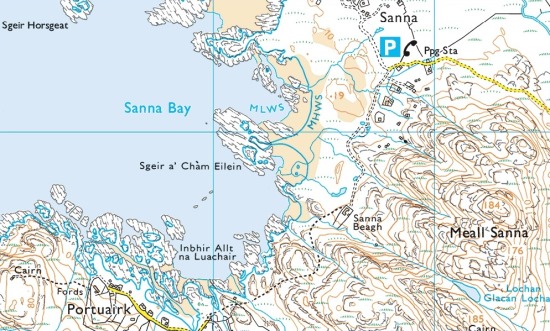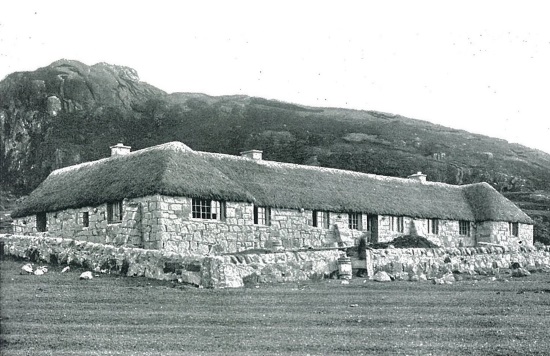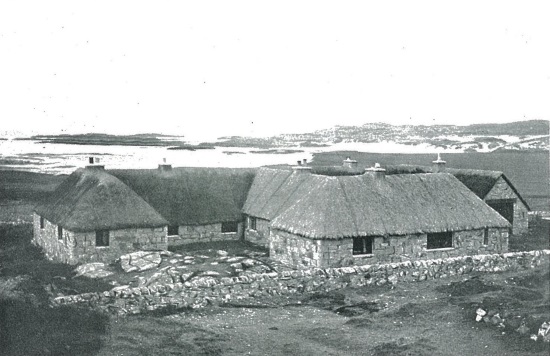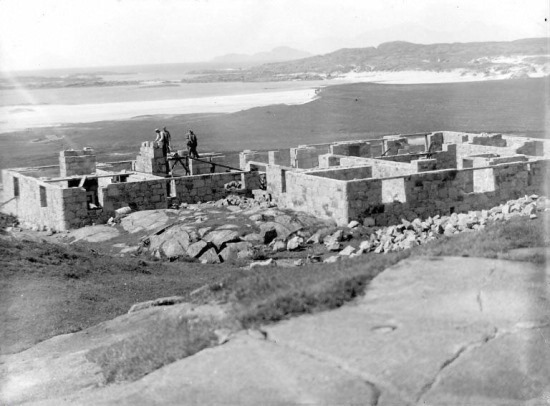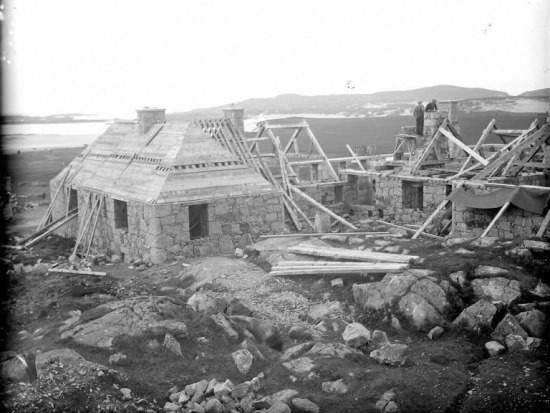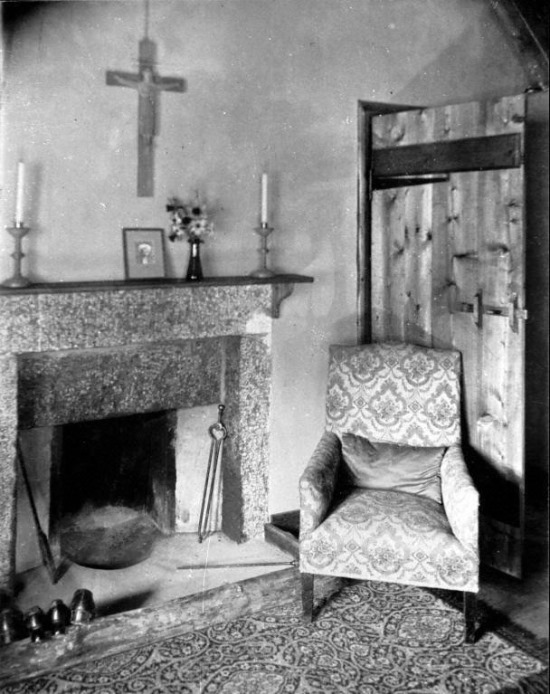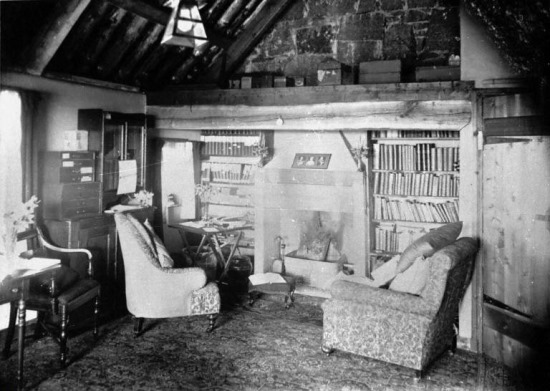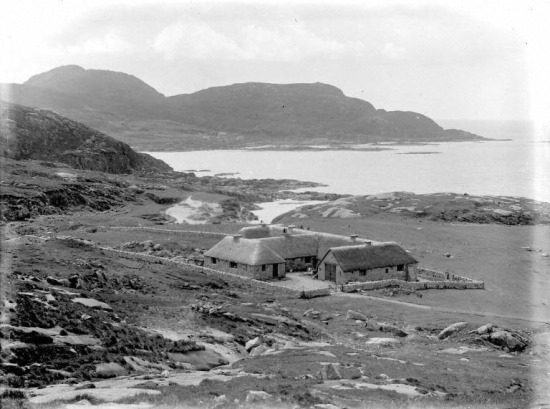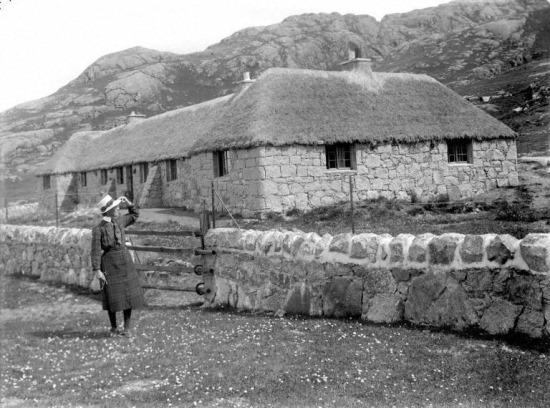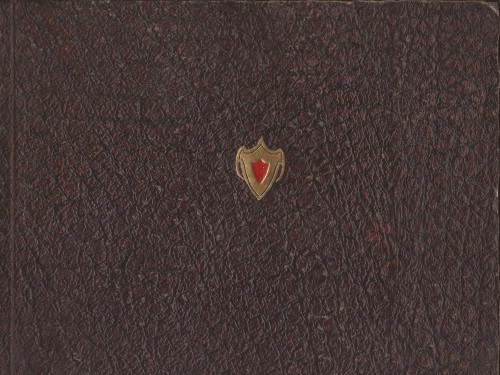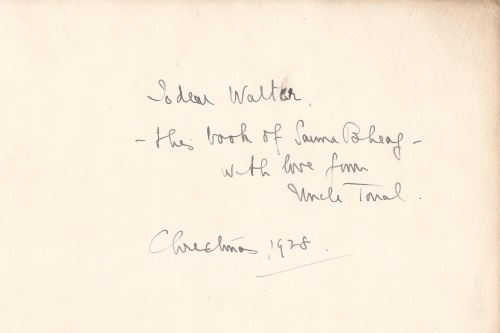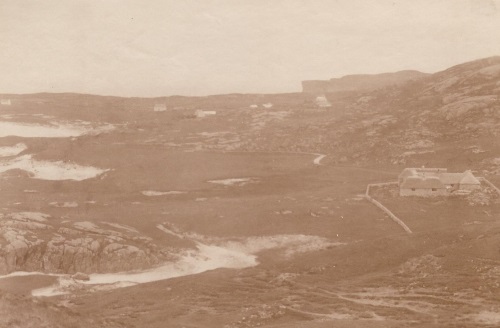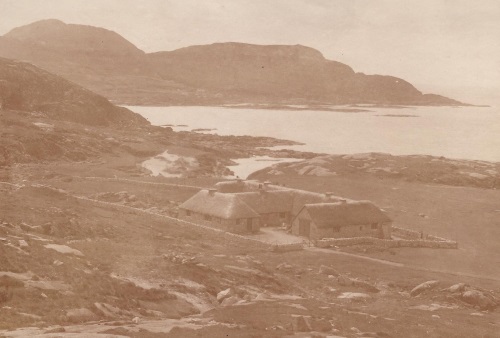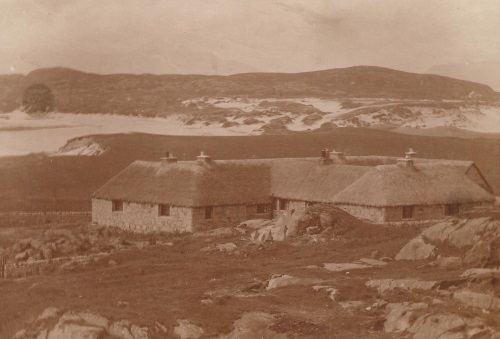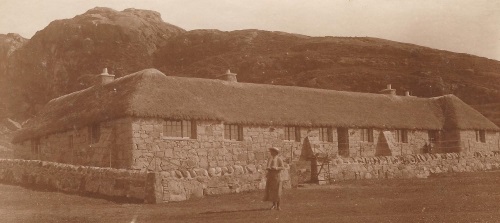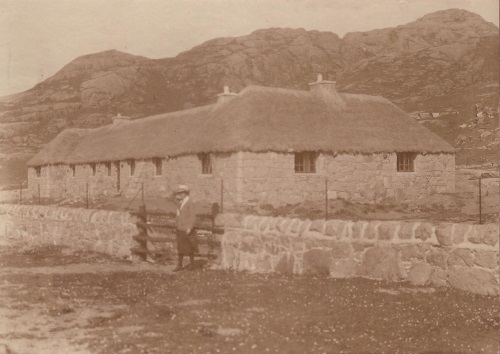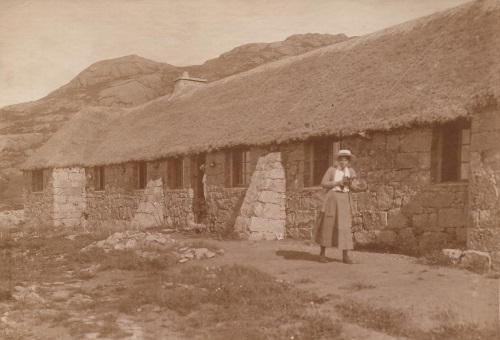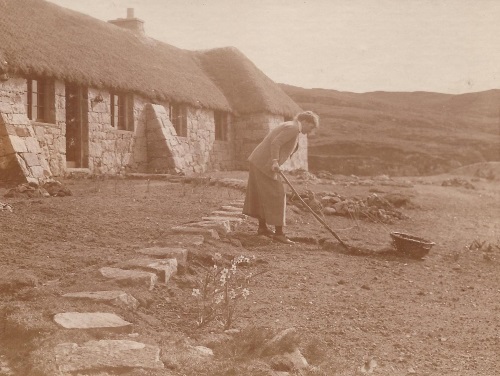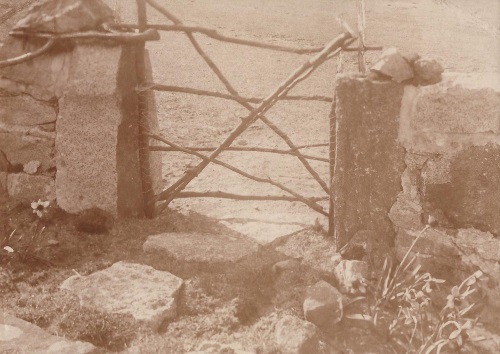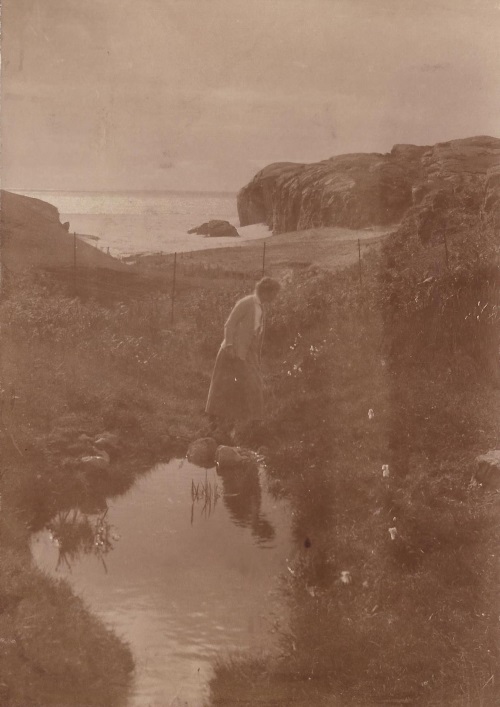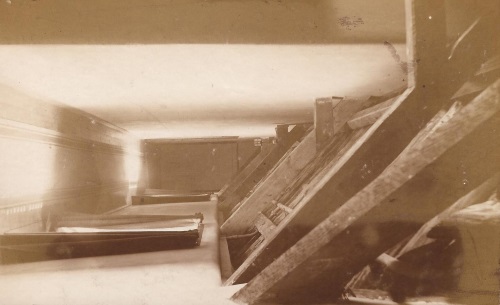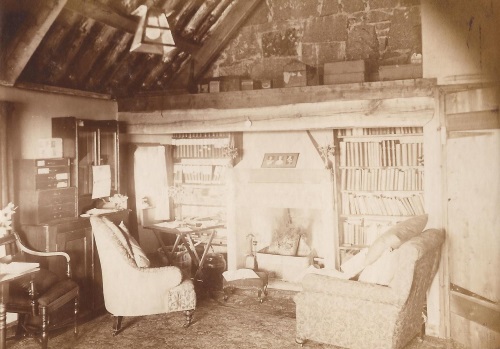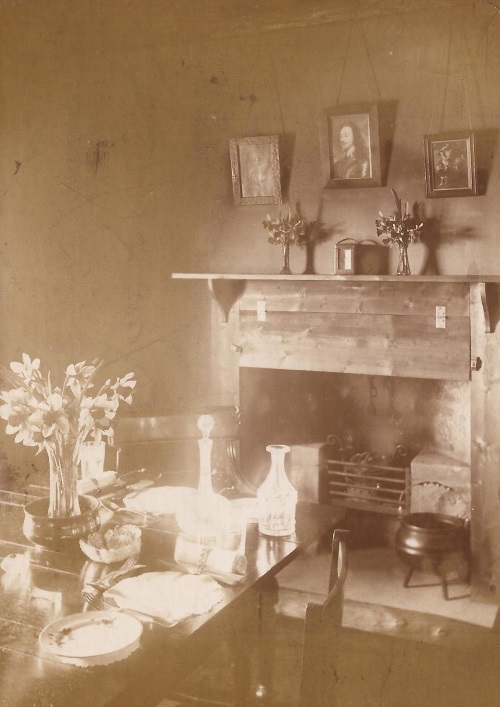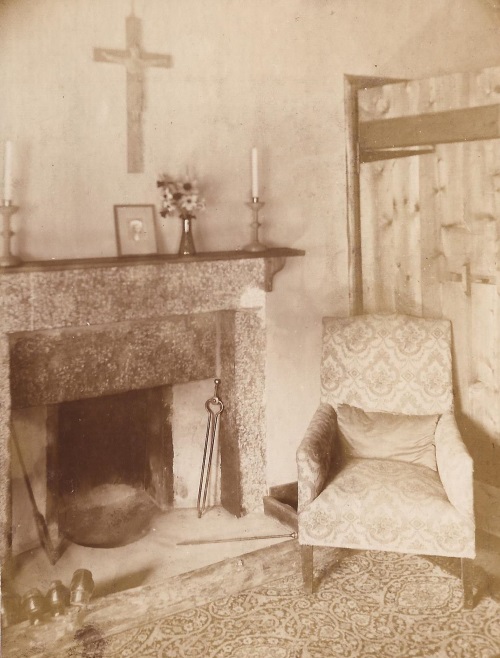Mary Ethel Muir (Uncle Tonal) Donaldson
(19 May 1876 – 17 Jan 1958)
The first point to settle is what we should call her. She didn't seem to care for her given names, and apparently preferred the acronym MEMD.
The populace of the Highlands & Islands simply said "Herself", a customary Celtic way of referencing a third party with a degree of respect, reluctant or otherwise, or even cautious affection.
But that would seem rather precious at this distance in time. Her first Christian name "Mary" she shared both with her mother and with her partner. So I've mostly settled for "May", short and sweet (she was indeed short – neat is a better word – though not always sweet), and used on at least one occasion by my late Aunt Jane. Another name, peculiar to our family, is introduced in just a moment.
This whole investigation, like so much else of this website, has for me been a foray into the unknown, and so it's appropriate first to present some of the preliminary material in episodic format.
REW email reminiscences (1) 2015
MEMD, known as Uncle Tonal within our family, was a great friend of my grandmother Hannah Findlay from the early 1900's onwards, and was godmother to my father Walter.
He was sometimes (or maybe just the once) sent to stay at Ardnamurchan during the summer holidays (and he hated it!) and I have a vivid recollection of her when she stayed overnight with my parents in about 1952 or 1953.
I'd like to find out just a bit more about her origins, as although my Aunt Jane strongly believed that MEMD's private means were sourced from her father's directorship of the Donaldson Shipping Line, I can find no evidence that he had anything whatsoever to do with it! Also, I think that it might throw light on my grandmother's life during that first decade – they could well have met before MEMD moved up to Scotland.
REW email reminiscences (2) 2015
As family things, even of the most innocuous nature, were on principle never discussed in front of children, I'm not really able to contribute a great deal to MEMD's biographical background.
I believe she had very intense High Anglican religious convictions, as did my grandmother Hannah Findlay, and perhaps that was the basis of their long friendship.
On the occasion of that visit to my parents' house when I was about 8, she presented me with a picture-book of English Kings and Queens but I was horrified to see that she'd scribbled 'Regicide' in orange crayon across the portrait of Oliver Cromwell (I'd always been told it was very naughty to scribble in books!).
At some point in my early teenage years (perhaps after MEMD's death in 1958), I was given a couple of thick quarto-sized ruled sketchbooks, containing a great many meticulous pencil drawings by Isabel Bonus, mainly of church architectural details and (I think, mediaeval or perhaps pre-Raphaelite) womens' dress – I can't be too precise at the moment as they're currently in a storage box, one of many yet to be unpacked following our recent move from Berkshire to Lancashire.
As his godmother, she might have been expected to leave a substantial sum to my father Walter, though I don't think she did. But (according to Jane) she settled a considerable sum on Frances, who like her had High Church leanings – in fact in later years Frances converted to Catholicism.
Aunt Jane phonecall (paraphrased) ca 2012
Despite her unconventional dress, and undeniable eccentricity, she was by no means (always) a figure of fun within our family, but we were ever so slightly irreverent about her – referring, for example, to her epic "Further meanderings, mainly in Argyll"
She had no education whatsoever, and her prose style was simply dreadful – her publisher used to plead with her to have her manuscript professionally edited before publication – he said it would increase her sales very substantially – but she simply refused.
She found it very hard to accept a different point of view – she had wanted to pay to have a road built to Ardnamurchan, but the locals objected strenuously – they didn't want a road – she just couldn't understand that.
Of course, you know she was a lesbian – that was understood within the family, but never discussed. She always wore men's clothing, and had her hair very short – she looked just like a little man, which confused Walter when he was little – he always called her Uncle Tonal, which greatly amused her.
Aunt Jane's subsequent letter ca 2012
(click here for pdf version)
MEMD is still remembered to the present day in Ardnamurchan, as witness the following recollections – which illustrate Aunt Jane's thesis that MEMD wasn't always sensitive to local points of view – especially in matters of religion: MEMD herself was born into the Church of Scotland (Presbyterian Calvinist, as is the Free Church of Scotland), but had moved across to the Church of England (Episcopal Anglican) in which she was very High Church (Bells 'n' Smells) though vehemently anti-Catholic!
She was a very interesting woman. We are very fortunate she took such a notion [fancy] to Ardnamurchan!
I heard a lot about her all my life. They liked her, they thought she was eccentric but felt she respected their way of life. She enjoyed interacting with the people that lived here, she was genuinely interested in their opinions. She had one of her cameras with her anytime they saw her, and they felt she was interested in the way they all went about their business but she didn't judge.
She would be jotting things down in a wee book she carried with her. They would see her doodling in her notebook and she was always drawing wee maps and taking note of all the routes the crofters walked through the hills as they went about their daily tasks - the walking paths over/through the hills they took to go to school and to church - the tracks the lighthouse keepers took from Achosnich to the lighthouse, and Portuairk to the lighthouse, and the coffin trails.
May MacNicol remembers being in Portuairk the night Sanna Bheag was burning. They could see it.
My grandfather James Macmillan was one of the local builders. He built quite a few of the traditional Croft houses after the [Great] War, when the government were giving grants to upgrade the standard of housing. That's when a lot of the very basic houses changed to the two-storey white Croft houses in the villages today.
So he was involved in transporting local supplies during the building of Sanna Bheag. His horse and cart is in the photos of the puffer beached at Sanna.
He was also the district councillor and a lay preacher. He took services in Sanna mission hall at 3pm on a Sunday if one of the ministers couldn't make it. One week it was Free Church other week Church of Scotland. I think this was why my grandparents were involved or knew MEM Donaldson. James Macmillan would be one of the go-to people in the area for someone like her coming in and wanting advice on how to go about living here.
My mother and all her 5 siblings were invited by MEM Donaldson to a Christmas party in Sanna Bheag. My grandmother was unsure if letting them go but grandad persuaded her it would be a nice treat for the children.
They were horrified when the children came home and told them that 'Mem' Donaldson had a decorated tree inside the house and one of the games involved dancing around it. To my Free Church grandparents, this was pagan behaviour. No good would come of that! For the Free Church of Scotland, Christmas is all about baby Jesus and not about presents and celebrating in fooling excessive ways ... No good would come of that!
That was the only big problem I've ever heard about in regards to her living here - Oh but I did hear that a lot as a child. It was held up as a very bad example.
How do we describe May Donaldson in modern terms?
A feminist? Not really, she simply ignored traditional gender demarcations and did what she saw as important.
A lesbian? Who knows? Who cares? Our modern Western "culture" regards sex as an all-important commodity, but maybe she was simply indifferent to hormonal urges and arbitrarily lit upon another woman, Isabel Bonus, to share her life with.
A religious fanatic? Yes, to a degree. I'd prefer to describe her as a mystic, who found that High Church Anglican ritual and liturgy brought her closer to God than did Roman Catholicism or Presbyterianism.
An undereducated amateur who dabbled in matters best left to the academic experts? Yes to the first proposition and No to the second. My father, when I was about eight or so, told me that (in the world of engineering) if something really revolutionary is required, it will be best accomplished by somebody who initially knows little if anything about the existing technology, as he is unaware that the experts have dismissed the required breakthrough as being totally impossible.
So what did she achieve? That's not for me to say, but it is clear in hindsight that she was amongst the very first ethnographers to record – and very importantly, to photograph – the traditional way of life of the impoverished Scottish northern & western Highlands and Islands, which had persisted unchanged for many centuries but vanished between the First and Second World Wars.
This picture, "Girl [Christina MacVarish] with Firewood", is so extraordinarily beautiful that it brings a tear to the eye and a lump to the throat. The composition is perfect, as are the focus and the light, and the winding road in the background tells the story of a long and painful trek in skimpy sandals. I could well believe it's among the finest photographs of all time. And there were thousands more May took that I've not even glimpsed yet.
In fact you can view a great many more (at thumbnail size) relatively easily on a couple of websites
- scran.ac.uk/search/ - use the Advanced Search facility with "Donaldson" + "Mary" + "Ethel", for example
- ambaile.org.uk/ - select the A-Z Subject Index, then "D" and then "Donaldson M E M"
Personally, I think her misty landscapes (or more often lochscapes) get a bit samey after a while, and I much prefer her wonderful images of the crofters themselves.
Biographical stuff
I would like to gratefully acknowledge my immense indebtedness first to Jen Guerin (who was also so wonderfully helpful with the Findlays and Ritchies) and latterly to Jennifer Morag Henderson.1, 2 They both generously made me aware of material from archival resources I would never even have known about, let alone investigated myself. The results are particularly evident in the Donaldson and Bonus families' Generation Tables.1, 2
I began to enquire into May Donaldson back in early 2013 in the hope that she held the key, or one of the keys, to unlock helpful details of my grandmother Hannah Findlay's 'missing decade' between finishing-school in Derby and setting forth to Seattle in 1912. But though quite a lot has emerged about May there's been no further light shed on Hannah – and now there's nobody else left to ask. Maybe future generations won't care particularly, but I do – she was Stella Polaris of my deeply muddled teenage years, and I'd like to have learned somewhat more of her own life in early adulthood.
(As you may well have noticed, I've devoted some considerable time to digging deeper into the pre-history of the Muirs, in an ultimately unsuccessful effort to establish that May and Hannah were related familially, and therefore became acquainted from childhood rather than via some unlikely chance meeting in Scotland during the 1900's. I'm still keeping my fingers crossed.)
But, back to May. She is always said to have been born in Lambeth (in 1876). No, that was the official registration district, but not necessarily the civic district (just as her brother John was born in Kenley, of which the registration district was Croydon). This suggests that the family moved further away from London in between those two births, perhaps as an economy measure.
There is fragmentary evidence that in Jul 1880 Mrs Donaldson, May's mother, advertised, in The Times, a carriage for sale at £100, that had cost 250 guineas only three months previously, and had been little used. Perhaps this indicates her exasperation at her husband's needless extravagance? It is known that his estate at his death less than three years later amounted to a mere £200, not much even for those days.
I'm not going to recount the standard narrative of her career in Scotland, as I'm principally interested in the ways she impacted on the various lives in our family. But I might make one or two additional points in passing.
There's a slight disagreement as to when she first visited Caledonia stern and wild – some say 1905¶, some 1908. Either way, she would certainly have headed straight for her spiritual home in the Highlands. I don't have any worthwhile opinion on this, except that her conditional (re)baptism1, 2 into the Church of England in 1907 might have some bearing on it.
There's also been a big muddle about the date of the fire at Sanna Bheag – some say in 1935¶, some 1947¶¶. But an eyewitness account is now able to settle the matter reliably.
...I had a chat with May [MacNicol] the other night, and she confirms that the year Sanna Bheag was burnt down, was indeed 1947. She lived in the neighbouring bay of Portuairk and though she was only 4 years old at the time, she clearly remembers the orange glow in the sky and the smell of the smoke. She says all the locals were absolutely devastated as they thought it was such a beautiful building and I suppose many of them had probably provided the unskilled labour for its construction. She said its loss was felt for quite some time in the community and there was a real sadness about it. She didn't believe MEMD was there at the time but wasn't sure as she [May MacNicol] was so wee. She can't remember any of the speculation at the time about the cause of the fire either.
I also wonder about the ultimate fate of all the MEMD material that my Aunt Frances sent to the Post Office at Kilchoan (at Aunt Jane's suggestion, after hearing that it was going to be given to Oxfam or some such charity shop) following May's death in 1958. Presumably the Kilchoan postmaster (or mistress) passed it all on to some academic institution as soon as the dust had settled.
In retrospect (Feb 2024) this theory is well-meaning but muddled. It has factual elements but in the wrong order: like Eric Morecombe it plays the right notes but not necessarily in the right order.
First and foremost, there is no evidence whatsoever that any items were left to the Kilchoan post office at the time of May's death in 1958 or gifted thereafter by Frances until 1996.
From letters that have just come to light, it now seems that Jane set the wheels in motion, and that it was just the one item that was especially prized...
B) A letter from Mrs Indecipherable of Doirlinn House, Kilchoan thanking Frances for the copy of 'Further Wanderings Mainly in Argyll'
C) A letter to Jane from Catriona McMillan of the Post Office, Kilchoan regarding copies of 'Annals of the Parish' (the second page has evidently been regenerated by Jane in her distinctive handwriting)
Perhaps Doirlin House doubled as the Kilchoan post office, and maybe Mrs Indecipherable was actually Catriona McMillan (whose surname was really MacMillan)?
And hopefully that copy of 'Further Wanderings Mainly in Argyll' continues to find appreciative new owners!
Isabel Bonus
May's soul-mate was Isabel Bonus, though she receives scant attention, if any, in the various potted biographies available – even Dunbar in "Herself" makes only occasional mention of her, though I may need to withdraw that remark when, if ever, all my books emerge from storage and I can read through them again.
Her family circumstances are documented well enough; prosperous though the elder cohort were, on the death of both her parents, the orphaned Isobel and her two surviving sisters were given into the care of two spinster schoolmistresses, with whom they continued to live for many years. But there is as yet no indication as to when Isabel was befriended by May, or when they became an item.
Quite possibly they didn't set up house together until Sanna Bheag had been built. I imagine that Isabel had some quite serious issues with her family's cavalier attitude towards herself and her sisters, and yearned for a stable domestic relationship.
Some examples of her remarkably meticulous sketchbooks will be put online ifsowhenever I regain access to them. Perhaps their exactitude reveals her longing for order and precision in her life. Perhaps I'm guilty of psychobabble.
Sanna Bheag
First let's do some Geography revision, as to where Ardnamurchan is exactly (the old County names may still be helpful, and will be restored all over (Great) Britain when I come to power – in May Donaldson's era it was part of Argyll). Oban, Fort William and Tobermory helpfully triangulate the area. Nowadays it's part of a bureaucratically-conceived concoction by name of Lochaber.
As can be seen, Ardnamurchan is very nearly an island. Wikipedia confirms this, though surely its figure for the area is much too small?
Ardnamurchan (Àird nam Murchan: headland of the great seas) is a 50-square-mile peninsula, noted for being very unspoilt and undisturbed. Its remoteness is accentuated by the main access route being a single track road for much of its length.
Strictly speaking Ardnamurchan covers only the peninsula beyond the villages of Salen (in the south) and Acharacle (in the north), but nowadays the term is used more generally to include the neighbouring districts of Sunart, Ardgour, Morvern, and even Moidart (which was part of the former county of Inverness-shire, not Argyll).
Now for Sanna Bay, relative to Ardnamurchan as a whole.
And now, for the almost unbelievably beautiful Sanna Bay itself, which lies between Sanna Point to the north and the Point of Ardnamurchan to the south (south west). To get a sense of the intimate scale, Sanna Bay is only a mile's walk from Portuairk or six miles' drive from Kilchoan.
And there too, would you believe, is Sanna Bheag (Little Sanna) itself, nestling at the foot of Meall Sanna (Sanna Hill), and connected to Sanna1, 2 and Portuairk1, 2 only by footpath.
I'm delighted to have just experienced (Feb 2020) an AHHA moment, as the psychologists express it, but in this case the receipt of a link to the Ardnamurchan History and Heritage Association, who enjoy exploring Ardnamurchan's past and working to discover, record and preserve the heritage of an almost unbelievably beautiful and historic corner of southwest Scotland (though course almost the whole of Scotland is also unbelievably beautiful and historic).
Particularly so in my case, as of course it was where M E M Donaldson (Uncle Tonal) and her partner Isabel Bonus poured their heart and soul into the building of Sanna Bheag, their house and haven in their exploration of that majestic coastline and the islands of Rum, Muck, Eigg and so many others.
M E M Donaldson,
"House at Sanna Bheag, Ardnamurchan, in the Western Highlands",
Country Life, Vol LXIV, No 1645, 28 Jul 1928, p 144
pamphletofarchitecture.blogspot.co.uk/2010/09/sanna-bheag.html
Pamphlet of Architecture
An Architectural History and Theory Blog.
Friday, 24 September 2010
Sanna Bheag, the home of Mary Ethel Muir Donaldson
Fashionable enough to be in Country Life but too anachronistic to be included in architectural discourse, Sanna Bheag, the Highland home of ethnographer and photographer Mary Ethel Muir Donaldson, doesn't deserve to be overlooked.
Taken from "Western Seaboard: An Illustrated Architectural Guide", by Mary Miers, 2008. Published by the Rutland Press
The house is large, single storey, loosely T-plan house conceived in the spirit of the Arts & Crafts movement and incorporating elements of the West Highland vernacular. It was built with low buttressed drystone walls of locally quarried blue granite and roofed with heather cut from a nearby glen, and with straw, laid over felt-covered sarking boards. Miss Donaldson employed local crofters - assisted by stonemasons from Tobermory - to build the house, and helped with the thatching herself. "In order to perpetuate native fashions throughout, we knocked the bottoms out of zinc pails for our chimney tops" she wrote in 1928. The house had its own hydro electricity and stood in a meadow enclosed by a drystone dyke, whose entrance gates she made herself from local timber
As a home contemporary to Loos' Moller House (1927) or Pierre Chareau's Maison du Verre (1928) Sanna Bheag cannot really be compared in modernist terms. But to say that it was 'conceived in the spirit of the Arts and Crafts movement' is misleading; the house is too grounded in its true vernacular and built as a response to Mary Donaldson's experience of photographing the Highlands and as such it's far more an essay in colonialism on our own shores.
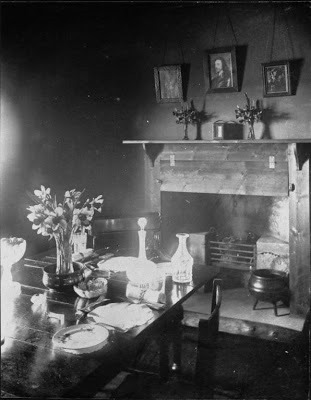
[This] photograph shows a plain polished dining table set for a meal with cutlery, crockery, glasses, a jug and a decanter. A vase of daffodils is placed in the centre of the table. Two wooden Sheraton-style armchairs are at the top and to one side of the table. The table itself is placed in front of the fireplace which has an iron bar grate. To the right hand side of the grate is a three legged iron cooking pot. The mantle is of wood, under which is a hinged panel probably to stop smoke getting into the room. On the wall above the mantelpiece are three pictures, the central one being of Charles I.
The fireplace appears to be of stone with fire tongs and a poker on the hearth. The photograph shows a wooden mantelpiece above which, on the wall, is a large crucifix. On the mantelshelf are two candlesticks with candles, a picture or photograph in a frame and a small vase of flowers. Beside the fireplace is an upholstered armchair which is placed on a patterned, floral rug. Behind the armchair is a wooden slatted door with a latch opening and iron hinges. On the fender by the hearth are shoes perhaps drying.
The photograph shows two armchairs placed either side of the fireplace on a patterned carpet. Bookshelves on either side of the fireplace are lined with books. Above the fireplace and the bookshelves, extending the entire length of the wall is a wooden beam. Above the beam is a storage area under the rafters of the roof, which has trunks and boxes stored. To the left of the room are a collection of small filing cabinets. The door to the right of the book shelves is slatted wood and has iron hinges and a latch handle. An electric light with a lantern shaped shade hangs from the ceiling.

This picture may relate to the hydroelectric generator that was installed nearby, to supply the house with electricity. We may surely suspect the guiding hand of her brother, John Muir Donaldson, a highly respected and successful electrical engineer.
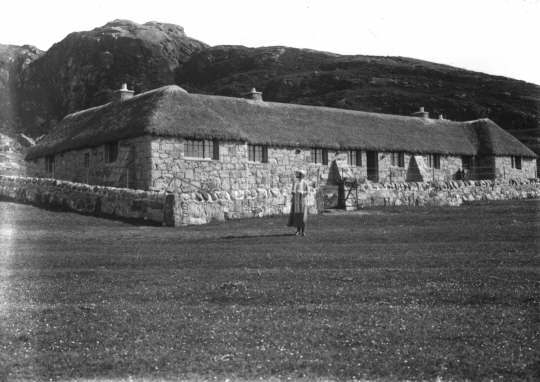
Slightly fortress-like in appearance (built to withstand fierce Atlantic gales), but undeniably snug withal. And is that Herself standing outside, or could it be the elusive Isabel?
Walter's Christmas Present 1928
Christmas can be, indeed often is, a tricky time for family dynamics when generosities and expectations fail to match up. The presents are meant to commemorate the gifts from the Three Kings (said to be Caspar, Melchior, and Balthazar, bringing gold, frankincense and myrrh respectively) aka Wise Men or Magi, to the infant Christ.
The sacrifices they offered were costly (a good Young Visiter word) enough, but those expected by the younger generation today are far more extravagant, necessitating card-crippling visits to PC World beforehand.
Going back a generation or two, things weren't so wildly out of hand, and I well remember getting a great deal of excitement and pleasure from all sorts of inexpensive things (from ones stocking, allegedly from Father Christmas, or from under the Tree, if my brother Simon hadn't got there first and opened everything at 5 am) that the children of today would pass over with a silent sneer.
Regressing a further generation, to one that had suffered the privations, bereavements and financial catastrophes occasioned by the Kaiser and the unspeakable Bethman-Hollweg, things were even more austere, but a chap might at least expect to cop a ten-shilling (£0.50) postal order from his wealthy godmother. Imagine my father's disappointment therefore, to receive but a homemade photograph album of her house and vegetable plot.
The album comprises five sheets, each with either 1 or 2 photograph(s) attached both front (A) and back (B). I've retained the contents of each side, but rotated those images which had required turning the album to look at.
There should be ten pages on display below, each indicated by its frame – nicely chosen framing, I hear you murmur. But, perhaps, shame about the pictures – I'll return to that further down.
Most of these pictures already appear in other sections of this webpage, so need little or no explanation. One point perhaps worth making is that Isabel was somewhat taller than May, and so should be easy to distinguish – though as always, never in close-up.
But the fact that MEMD provides no captions suggests that Walter was already acquainted with Sanna Bheag, and that it had been in the summer of 1928, at the age of 15, that he had been sent up there to kick his heels in frustrated boredom for goodness knows how long. He yearned for the bright lights, glitter and razzmatazz of the big city, not the endless tidal ebb and flow, the sunrise, the sunset, not to mention screaming bloody seagulls, of a remote Scottish shore.
On another tack, I do like the picture (5A) of the apparently stranded vessel. Those of you who spent your formative years reading the wonderful Para Handy stories will realise that this is a Puffer, one of the motley fleet of cargo vessels that plied up and down the Clyde and up along the coastline to Loch Fyne, even Oban and the outlying Islands, collecting and delivering all manner of goods and livestock to the coastal communities. Their flat bottom allowed them to beach and unload at low tide, essential to supply remote settlements without suitable piers.
Now perhaps it's time to grasp the nettle of picture-quality. Photographic technology was already highly developed by the time May started her ethnographic career, and it's just a shame that many of her pictures are indisputably substandard, though of course she was on a learning curve as regards developing and printing her images.
I can't do much to improve this, other than by application of the Autocorrect facility in Microsoft Office Picture Manager, which lightens (and possibly sharpens) a jpg image, but sometimes over-cooks the colouration. There is a persistent crimson hue that I can't dislodge. Perhaps (say) Photoshop could do a better job, but I don't know how to use it, and haven't the time to learn.
So please click here to see how this blind mouse runs with AutoCorrect.
Her books
From what little I've had the opportunity to read so far, I find her prose style perfectly acceptable, and I look forward to enjoying a great deal more in my declining years (which start any day soon). I also have a great deal of sympathy with her outlook on life, and would have loved to spend time with her (and Isabel of course), not least because I (personally) think she was remarkably, though austerely, beautiful.
In order of publication, her literary output was as follows – not much, you might say, but just think of all the ground she covered, both metaphorically and literally. She was one tough cookie, and so too was the enigmatic Isabel. Respect to them both.
- The Isles of Flame: a Romance of the Inner Hebrides in the days of Columba (1913)
- Tonal Mactonal (sketches) (1919)
- Islesmen of Bride: pictures of Native Life in certain of the Hebrides (1922)
| Wanderings in the Western Highlands and islands: Recounting Highland and clan history traditions, ecclesiology, archæology, romance, literature, humour, folk-lore, etc (1923)
(Her transcription of the Highland pronunciation and syntax of Donald Macallister the Arisaig boatman is remarkably similar to that of Neil Munro's immortal Para Handy, one of Scotland's greatest gifts to literature, a testimony to the fidelity of both.) | ||
| Further Wanderings - Mainly in Argyll: Recounting Highland History, Traditions, Ecclesiology, Archaeology, Romance, Present Conditions, Crofters' Life, and Wild Life, Humour, Literature, Folk-Lore, etc (1926) |
- Scotland's Suppressed History (1935)
- Till Scotland melts in Flame: Talks on Scottish Church history for young people, etc (1949)
It's nice to find that there is an electronic copy of "Wanderings", accessible on-line:
As always with such online facsimile versions, the maximal screen display can be achieved by using a judicious combination of the options Fullscreen / F11 / Hide Nav Bar / Zoom custom ...%
But, disappointingly, "Further Wanderings" isn't (yet) available in this format. Though in partial recompense there does exist an electronic copy of "The Isles of Flame", a sort of saints and sceptres saga, with watercolour illustrations by Isabel Bonus.
As always with such online facsimile versions, the maximal screen display can be achieved by using a judicious combination of the options Fullscreen / F11 / Hide Nav Bar / Zoom custom ...%
Unpublished works
Regular visitors (if such exist) to this website probably come to recognise that the individual sections are sui generis, written sometimes years apart, and often mutually inconsistent to a greater or lesser extent. Rather like life itself, really. I don't make excessive efforts to harmonise minor discrepancies, though I do try to correct more flagrant faults (such as when I recently realised that MEMD, though a High Anglican, was as implacably opposed to Roman Catholicism as she was to Presbyterianism).
Recent discovery of several unpublished manuscripts of hers – particularly her autobiographical memoir – will undoubtedly correct or clarify a lot of things we thought we knew about her early life, her political and religious convictions, and her intense, though platonic, love for her didymic complement, her anti-twin, the elusive Isabel Bonus.
Her extant documents are all in the old-fashioned Large Post Quarto size, 8" x 10", ie 203.2 x 254 mm, and give or take a millimetre here or there that's what they have been scanned at. Those proportions are rather congenial to creative thought and expression, and make remarkably pleasant reading.
Aunt Jane's remarks about MEMD's allegedly clunky, uneducated prose-style seem miles wide of the mark. Yes, she's very closely concerned with Anglican theology, and its backdrop to her relationship with Isabel Bonus, but IMHO her writing sparkles, save perhaps in the final title where maybe it's over-intense.
Please click below to select a title.
- A Pebble on the Beach
- A Voice from a Highland Scrap Heap
- The Old Religion
- Royal Innocent – the Forgotten Princess Elizabeth
Biographies
| 1a) | 
John Telfer Dunbar, Herself The Life And Photographs Of M E M Donaldson, William Blackwood and Sons. Edinburgh 1979. Softcover; ISBN: 9780851581330 | |
| 1b) | The photographs of M E M Donaldson, Allan and Elizabeth MacDonald, West Word, Apr 2005
as per road-to-the-isles.org.uk/westword/april2005.html | |
| ¶ | 2) | 
Elizabeth L. Ewan, Sue Innes, Sian Reynolds, Rose Pipes (Editors), The Biographical Dictionary of Scottish Women: From Earliest Times to 2004, Edinburgh University Press 2006, ISBN-10: 0748617132, ISBN-13: 978-0748617135 pp 98-99: Donaldson, Mary Ethel Muir, by HC (Professor Hugh Cheape) |
| 3) | huntlyexpress.co.uk/Whats-On/Lead-Stories/Close-up-on-female-photographer-16032015.htm | |
| 4) | M E M Donaldson, "House at Sanna Bheag, Ardnamurchan, in the Western Highlands", Country Life, Vol LXIV, No 1645, 28 Jul 1928, pp 143-145 | |
| 5) | pamphletofarchitecture.blogspot.co.uk/2010/09/sanna-bheag.html | |
| ¶¶ | 6) | Pls google blaven.com or click here |
| 7) | annenewman.com.au/mesmerising-memories-of-mem-donaldson |
Decline and Fall
We have all in our various ways been expelled from Eden, the final fizzle of our utmost strivings to create something beautiful and worthwhile; it's probably predicated by the small print in the laws of physics, not that that's any consolation.
The Romans wisely ordained a slave in the triumphal chariot to whisper "Memento mori" into the probably-inattentive ear of a military or civic hero as he progressed through the cheering crowds. And who can forget Poussin's haunting allegorical phrase "Et in Arcadia Ego" (which I prefer to the painting itself) – the ambiguity has always puzzled me – did it mean "I was not always as you see me now", or was it "I'm the spectre at your feast" – two entirely complementary viewpoints. Having just googled the matter, I now see that this question has exercised many a better mind than mine over the last few centuries.
We know from official records that Isabel Bonus died in 1941, at a nursing home in Oban.
- I have heard it said that she died of acute peritonitis, and that medical attention was seriously delayed because of the continued lack of a well-metalled road between Ardnamurchan and the world outside.
- I've also seen it said¶ that Sanna Bheag had been sold in 1935, and May Donaldson had, in disillusionment, abandoned her West Highland idyll for Somerset, and later Edinburgh.
These two statements are at odds with one another. Another account says, more plausibly that Sanna Bheag burned down in 1947, following which May moved directly to Edinburgh, dying there in 1958.
It's noteworthy that Isabel's address in her probate record is given as Kilcheran House, Isle of Lismore,1, 2 Argyllshire. If she had been ill for some time beforehand, she (and May too, perhaps) might well have temporarily relocated to Kilcheran for easier access to better medical facilities in Oban – although situated on the Isle of Lismore just offshore, Kilcheran is not far from Acnacroish, which has a regular ferry service to and from Oban. Or perhaps their bond of friendship had frayed and she had simply relocated – we shall never know (unless the visitors book at Kilcheran House has survived).
Whatever the precise details of how and where their renowned wanderings ended, they lie at rest together in an Oban graveyard. (The Scotttish Episcopal cathedral in Oban is surrounded by urban development and has no churchyard of its own, but I understand from the Very Rev Nicki McNelly, Provost of the cathedral, that they use use the local council cemetery, Pennyfuir, so maybe that's the one).
Edinbrovian enigmas
May spent her declining years in Edinburgh, and doubtless was a familiar figure amongst the congregation in Edinburgh Cathedral at every service in the Anglican calendar.
And in her Will, she left a considerable amount to the Episcopal Cathedral of St Mary in Palmerston Place, not to be confused (least of all by Herself) with the Catholic Cathedral of St Mary in York Place. The legacy was intended for the refurbishment and further adornment of the chapel of All Souls, and its rededication to King Charles I and All Souls.
There was indeed a service of rededication in Aug 1960, but when (in response to a request by Grannie Waddell) Uncle Sandy dropped by a year or two later, nobody seemed seemed to know anything about what had happened or why. Rather dispiriting for the shade of Uncle Tonal. And indeed, though I have searched exhaustively, there is nothing about it on any of the Cathedral's online resources.
Sandy described his disappointing visit in a letter of Oct 1996 to a correspondent unknown, though clearly of Scottish origin, who had evidently contacted him on the subject of MEMD in general, though seemingly they had known little about her connection with the Waddell family, or indeed who this family was. Good grief, how could that be possible?!!
Their resting-place
The pictures below are reproduced from the superb webpage
which you really should read first.
My wife and I visited Oban in the late 1960's, utterly impecunious students who had driven up from Norwich for reasons which neither of us can now remember, in a beat-up Ford Anglia estate car in the back of which we slept overnight, with the tail-gate up to minimise condensation. I awoke in the early dawn, with an indescribable sensation in my toes, and sat up to find that the nether end of my sleeping-bag was being chewed by a sheep. (There were other rude – or comical – awakenings on that trip which, as Michael Flanders famously remarked, I'll tell you all about some other time.)

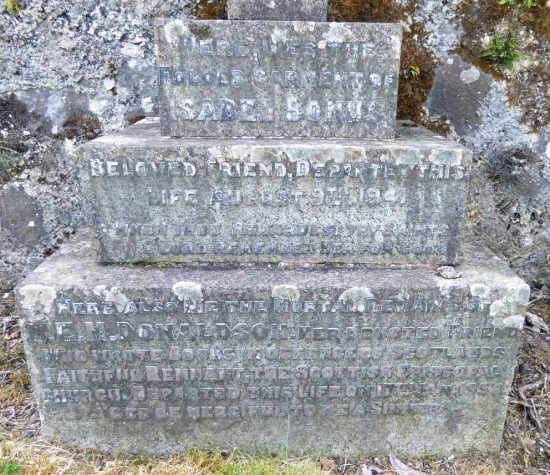
R.I.P.
HERE LIES THE
FOLDED GARMENT OF
ISABEL BONUS
BELOVED FRIEND DEPARTED THIS
LIFE AUGUST 9TH 1941
WHEN THOU REWARDEST THY SAINTS
O LORD REMEMBER HER FOR GOOD
HERE ALSO LIE THE MORTAL REMAINS OF
M.E.M. DONALDSON, HER BELOVED FRIEND
WHO WROTE BOOKS IN DEFENCE OF SCOTLANDS
FAITHFUL REMNANT, THE SCOTTISH EPISCOPAL
CHURCH, DEPARTED THIS LIFE ON 17TH JAN. 1958
"GOD BE MERCIFUL TO ME A SINNER"



